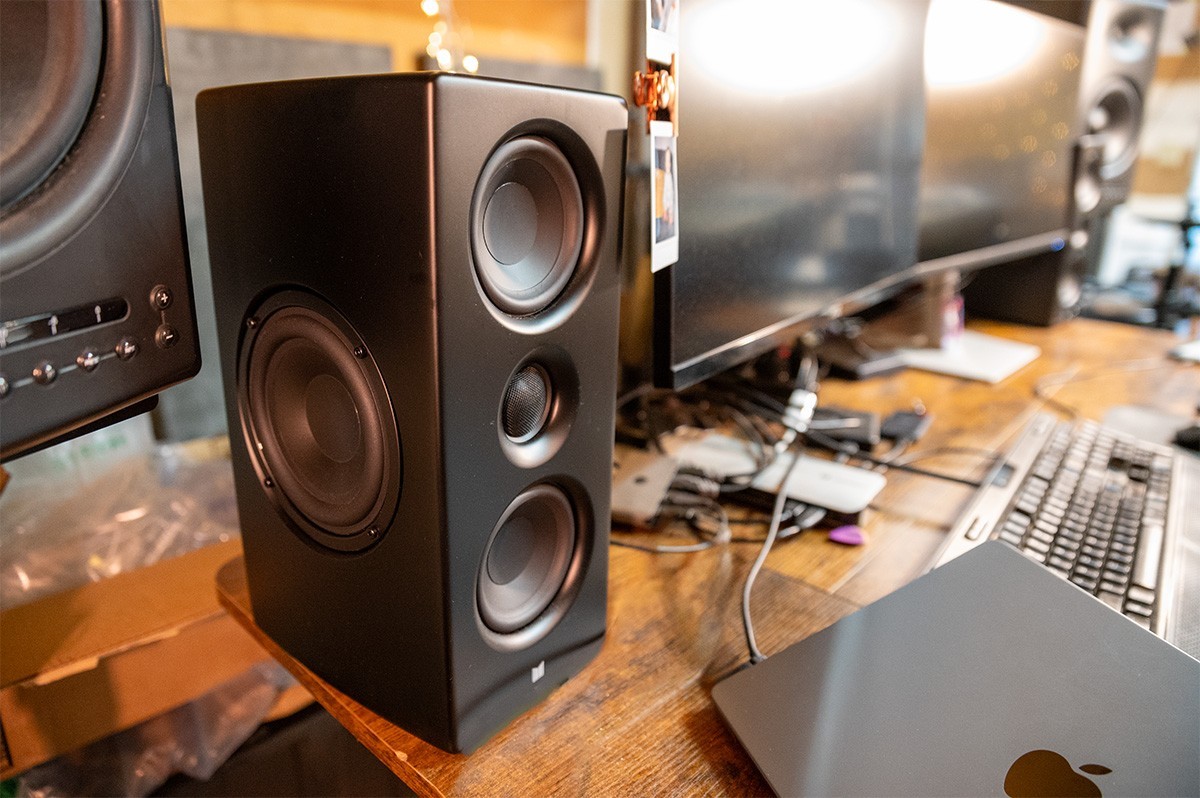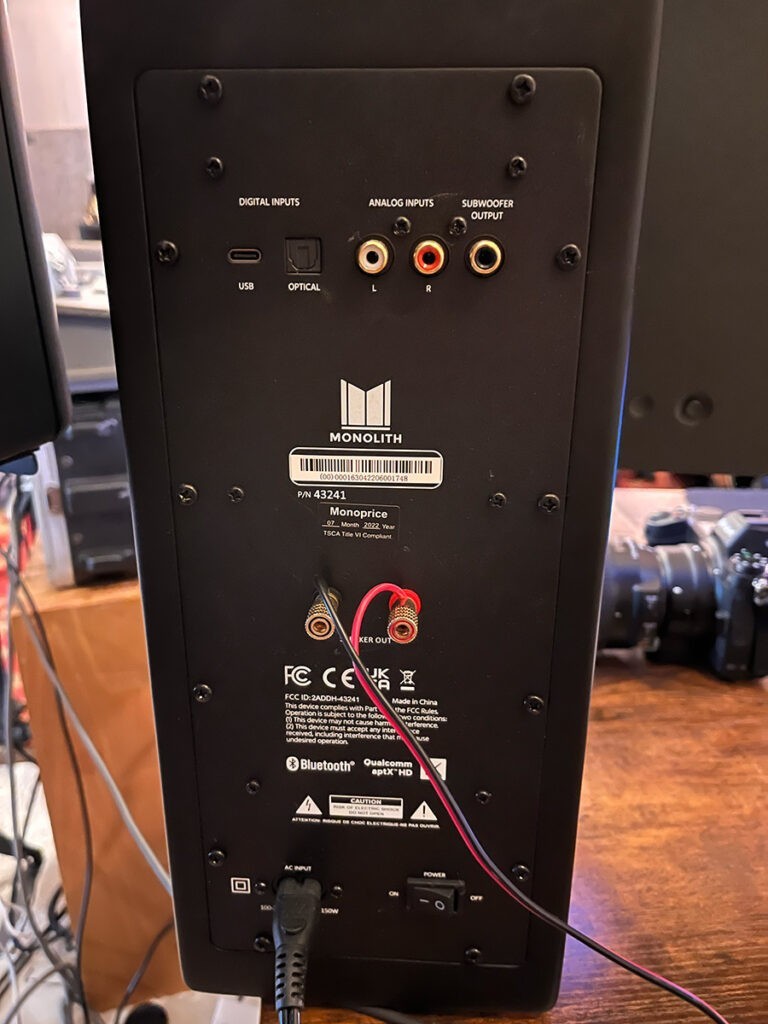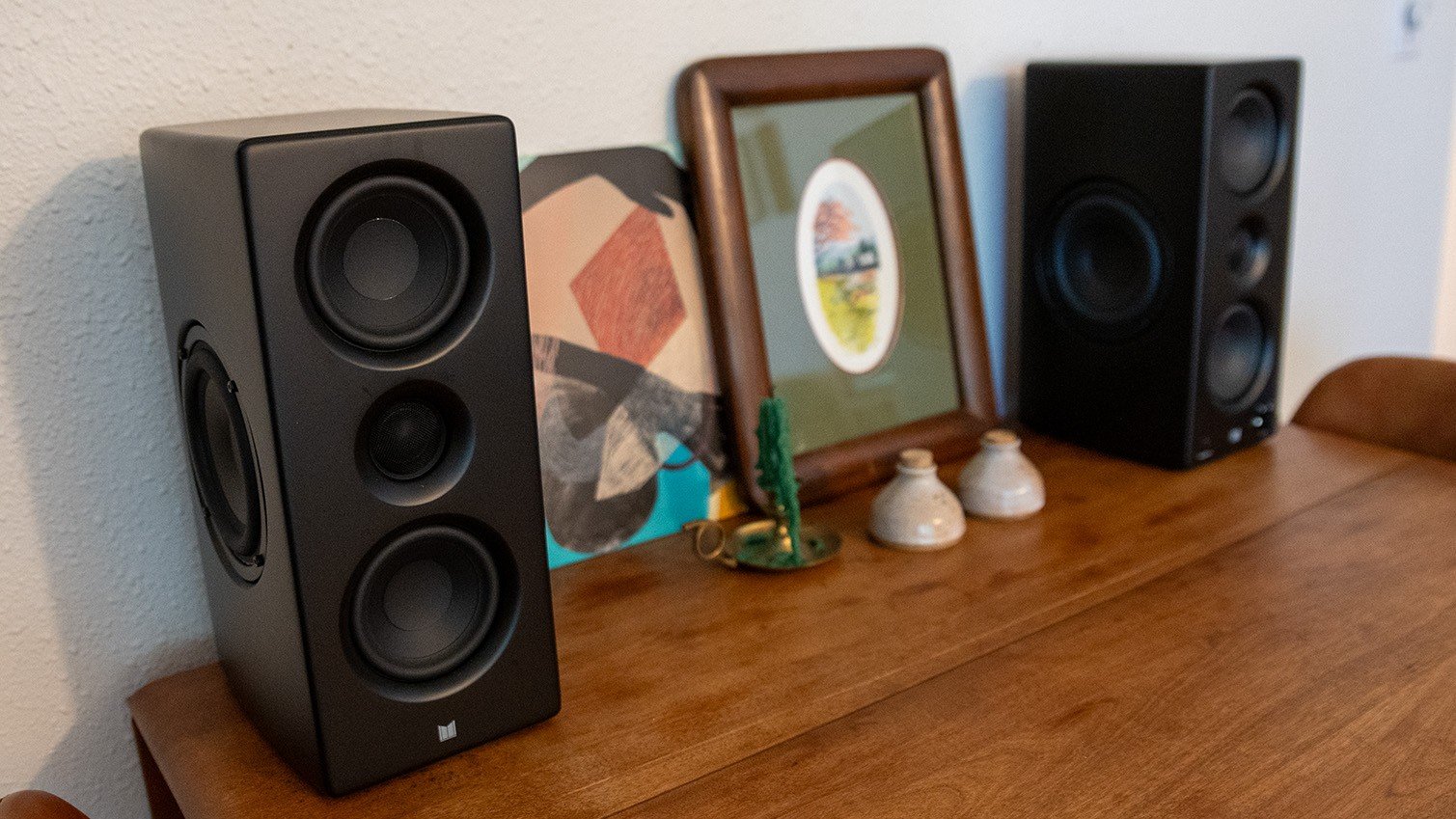Monolith MTM Desktop Speakers
All things considered, the Monolith MTM Desktop Speakers make a solid case for themselves with their sleek design, variety of features, and decent sound quality. They’re ideal for desktop use, offering an immersive listening experience right at your workstation. However, prospective buyers might want to take note of their quirks before making a purchase.
WE LIKE
WE DON'T LIKE
- Solid wireless performance via Bluetooth
- Handy remote control included
- Multiple connectivity options
- Distortion at high volumes
- Durability seems questionable
WE LIKE
- Solid wireless performance via Bluetooth
- Handy remote control included
- Multiple connectivity options
WE DON'T LIKE
- Distortion at high volumes
- Durability seems questionable
Recently, I had the privilege of receiving the Monolith MTM Desktop Speakers on loan for review. As an audio enthusiast, I am regularly exposed to a wide array of audio equipment. The MTM Desktop Speakers combine sleek aesthetics, modern features, and remarkable sound quality. The Monolith team has made a commendable effort in designing these speakers, but do they hit all the right notes? Here’s my in-depth review after spending quality time with them.
Aesthetics and Design
Crafted with an eye for aesthetics and functionality, the Monolith MTM Desktop Speakers come in a sleek satin black finish. This neutral tone makes them versatile enough to fit seamlessly into most room decor, be it modern minimalist or traditional. The rounded corners lend the speakers a soft and inviting feel, straying away from the sharp, angular designs of some other Monolith products. Take, for example, the hard and pointy corners of the Monolith Encore line. However, the all-purpose volume knob being made of plastic comes as a minor letdown, though it performs its function adequately.
The speakers’ compact size makes them ideal for desktop use. Despite their small footprint, they pack a punch with the variety of sound technologies incorporated within their unassuming exteriors. The design features dual 4″ woofers per speaker and a 1″ silk dome tweeter, promising a full-bodied sound experience from low to high frequencies.
One of the notable elements of the Monolith MTM Desktop Speakers is the inclusion of two 5.25″ passive radiators. A passive radiator is a type of driver that’s used to enhance the low-frequency (bass) response in speakers. Instead of producing sound on its own, it resonates in response to the air pressure changes in the speaker cabinet, generated by the active drivers (in this case, the dual woofers). The inclusion of passive radiators often results in a more significant, deeper bass response than what could be achieved by the active drivers alone, especially considering the speakers’ compact size.

Sound Performance
In terms of sound performance, the Monolith MTM Desktop Speakers do not disappoint. Their sound output is characterized by a well-rounded low end, an ever so slightly shrill yet detailed treble, and a full midrange. However, it’s worth noting that these speakers are designed for close-range listening, like at a desk, rather than filling larger spaces with sound.
The imaging on these speakers was a pleasant surprise, offering a more expansive soundstage than I anticipated. While the built-in EQ settings are user-friendly, the speakers felt a bit dull when left at a flat setting. However, they responded well to a classic V-shaped EQ to liven things up a bit.
While the speakers deliver overall good sound quality, they aren’t without some quirks. When the volume from a plugged in source device is set too high, distortion becomes noticeable. An easy workaround for this issue is to keep the source volume lower and adjust the speaker volume to your liking. Additionally, the speakers have a slight delay before they start playing audio, which means you might miss the first few seconds of a track unless you manually rewind.
The speakers are equipped with a decent built-in DAC, which stands for Digital-to-Analog Converter. This component takes the digital audio information from your device and converts it into an analog signal that the speakers can output as sound. The DAC’s performance was tested against a Schitt Modi+ and held its own, proving it a good match for the speakers’ quality.

Connectivity and Usability
The Monolith MTM Desktop Speakers come with an assortment of connectivity options. This includes traditional wired connections like RCA and 3.5mm inputs, as well as digital inputs through a Toslink optical cable or USB-C. Wireless connectivity through Bluetooth 5 with aptX HD is also available, promising high-definition audio even without the wires.
The speakers’ Bluetooth function is particularly worth noting. Qualcomm’s aptX HD audio codec used here ensures your Bluetooth-enabled device can deliver high-definition audio wirelessly. It preserves sound data during transmission, offering a ‘better than CD’ listening experience.
However, since I only had my iPhone 13 Mini to connect via Bluetooth, I was limited to the SBC codec rather than the superior aptX HD. But really, that should be considered a knock against Apple, not something to hold against these MTM’s.
A convenient feature is the front headphone jack, allowing you to switch easily between the speakers and headphones. The remote control is also a handy inclusion, offering controls for volume, input selection, Bluetooth pairing, and adjusting treble or bass settings.
Long-term Use and Value
In terms of durability, the Monolith MTM Desktop Speakers seem built to last, albeit feeling somewhat light for their price range. The included rubber feet are a nice touch to ensure desk stability, which could enhance longevity if the speakers are primarily used in a desktop setup.
As for value for money, it seems a bit subjective. On one hand, the speakers offer a plethora of features, decent sound quality, and aesthetic design. However, the issues with distortion at higher volumes, sound delay, and the control knob’s slightly flimsy feel might be factors to consider. While they might feel slightly overpriced at $499 MSRP, their value largely depends on what you’re looking for in a desktop speaker system.
Competitors
While the Monolith MTM Desktop Speakers provide quality listening, they don’t exist in a vacuum. Are there desktop speakers that I would pick over the Monolith MTM that fill the same niche? Yes. At a similar baseline price, I preferred the Audioengine A5+, which Audioengine considers best used in the living room but I’ve seen used to great effect in offices as well. For just a bit more, the Audioengine HD4 speakers provide good sound and a more pleasant aesthetic.
Conclusion
All things considered, the Monolith MTM Desktop Speakers make a solid case for themselves with their reasonable design, variety of features, and surprisingly good sound quality. They’re ideal for desktop use, offering an immersive listening experience right at your workstation. However, prospective buyers might want to take note of their quirks before making a purchase. Ultimately, these speakers stand as a testament to the fact that good things do come in small packages – albeit with a few caveats to keep in mind. As always, Monolith has delivered an impressive piece of hardware that challenges our expectations for what’s achievable in the price-to-performance ratio for audio equipment.

With over a decade of experience in the Western Washington music scene, Jonathan has been around high-end audio equipment for quite some time and has a particular love for music, technology, and audio gear of all kinds. He runs a small record label and has engineered, mixed, and mastered award-winning albums from local musicians. He currently lives close to the Canadian border in Washington state with his wife and daughter.
Post Disclaimer
Some of our content may contain marketing links, which means we will receive a commission for purchases made via those links. In our editorial content, these affiliate links appear automatically, and our editorial teams are not influenced by our affiliate partnerships. We work with several providers (currently Skimlinks and Amazon) to manage our affiliate relationships. You can find out more about their services by visiting their sites.




Similar threads